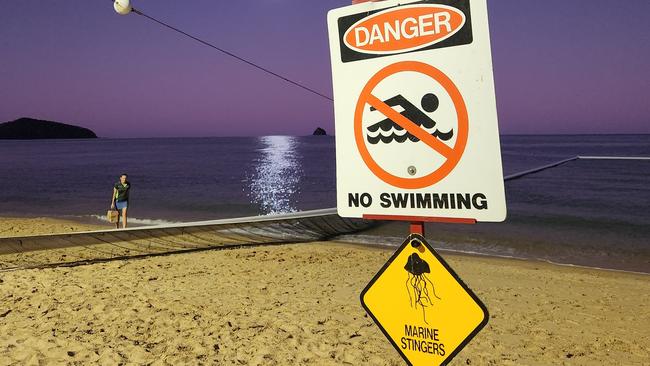Two in Hospital with suspected Irukandji stings at Palm Cove beach
A young boy who swam at Palm Cove beach was among six presentations to Cairns Hospital with suspected Irukandji stings.
Cairns
Don't miss out on the headlines from Cairns. Followed categories will be added to My News.
A young boy and a middle-aged woman were rushed to Cairns Hospital on Sunday afternoon with suspected Irukandji stings while swimming at Palm Cove beach.
Paramedics responded to reports of a primary-school aged boy with a suspected Irukandji sting on his back about 4.15pm.
The boy was screaming in agony while a panicked woman, believed to have been the boy’s mother, held his hand.
Lifeguards were seen treating the boy with oxygen.

The boy was transported to hospital from Palm Cove Beach in a stable condition. A QAS spokesman confirmed the boy had symptoms consistent with Irukandji envenomation.
Paramedics were then called again to the same spot about 4.45pm to reports of another suspected Irukandji casualty – this time, a woman who had been stung on her legs.
She was transported to hospital in a stable condition with similar symptoms to the boy, the QAS spokesman said.
Marine stinger warning signs and flags were present in front of the beach.
Up to a dozen people were seen swimming outside Palm Cove beach’s stinger nets about 4.15pm. About 50 people were seen entering the water and swimming at the beach, including inside the nets, while lifeguards treated the boy.
But a Cairns paramedic said the stinger nets at beached such as Cairns actually provide no reliable protection against Irukandji as the holes within the net are not sufficiently small enough to prevent them from entering the swimming area.
“The lifeguards do sweeps, but the Irukandji can drift in the interim … the nets provide no protection. It’s always a possibility that they’re there,” Scott Cooper, the manager of clinical education at Cairns Station, said.
“The biggest issue with Irukandji is symptoms don’t usually present until 20 to 45 minutes after the sting. That’s when symptoms worsen, and the pain is extremely intense.”
Mr Cooper said if a person believes themselves to be stung, they should call an ambulance immediately, locate the affected area of the body and douse it in vinegar.
“The area can be tough to find, but reddening and goosebumps are a common sign,” he said.
“The biggest risk is people with pre-existing conditions: the elderly, children and people with heart conditions. An Irukandji sting elicits high blood pressure.”
A CHHHS spokeswoman said six people, including the boy and the middle-aged woman, presented to Cairns Hospital with confirmed Irukandji stings, all of whom have since been discharged.
Cairns Surf Life Saving Club has been contacted for comment.
More Coverage
Originally published as Two in Hospital with suspected Irukandji stings at Palm Cove beach




